| | |
| | |
| | |
| | |
ORNAMENTS
Indian woman are very fond of ornaments. Indian ornaments, have a variety of design and style, both traditional and modern. Each area in India has a particular style of design which is quite distinct from the others. Some of them are traditional symbols. Small and simple ornaments are used as casual wear. Heavy ornaments are used for occasions.
NOSE RING
It is a traditional custom for Hindu married women to wear a stud or a nose ring. Women pierce their nose either on one side or on both sides. Gold or silver studs embedded with stones of different sizes and shapes are worn. Small rings instead of studs are also used. The nose ring is considered as a symbol of marriage. Nowadays it is also worn by unmarried girls.
Ear ring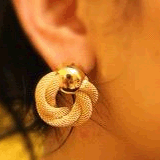
It is a 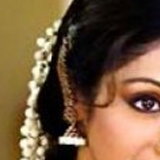 common custom among Indians, to pierce the ears of a baby girl few months after her birth. Women wear different types of studs and hangings. These days women pierce their ears on the lobe and ornament themselves very attractively. On the occasion of marriage, very big hangings are used by brides. Ear rings of various metals like gold, silver, white and black
common custom among Indians, to pierce the ears of a baby girl few months after her birth. Women wear different types of studs and hangings. These days women pierce their ears on the lobe and ornament themselves very attractively. On the occasion of marriage, very big hangings are used by brides. Ear rings of various metals like gold, silver, white and black metal are used. A thin chain attached to the ear studs with the other end pinned to the hair is called 'Maatty'.
metal are used. A thin chain attached to the ear studs with the other end pinned to the hair is called 'Maatty'.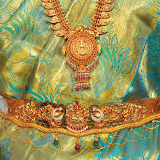
There are few other ornaments used by women occasionally. On the wedding day, apart from the usual jewels, a big golden waist chain (Odyanam) is worn. It is worn around the waist and at times only on the left waist. It keeps the sari intact besides being an ornament. A thin chain worn on the center part of the head with a drop in front is called 'Chutti'. An ornament called 'Vangi' ![]() is worn on both hands above the elbow. These ornaments are also used by dancers during performances.
is worn on both hands above the elbow. These ornaments are also used by dancers during performances.
BANGLES
India has a large range of arm ornaments. Bangles are popular among women. It is mad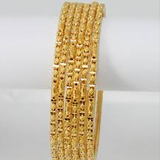 e of gold, silver, glass and many other materials. In some parts of India, women wear glass bangles of different colours which match their dress. Jaipur, in Rajasthan is a big centre for lac bangles. They are worn on auspicious occasions as a sign of good omen. A pair of shell and red coral bangles are worn by Bengali women as a symbol of marriage.
e of gold, silver, glass and many other materials. In some parts of India, women wear glass bangles of different colours which match their dress. Jaipur, in Rajasthan is a big centre for lac bangles. They are worn on auspicious occasions as a sign of good omen. A pair of shell and red coral bangles are worn by Bengali women as a symbol of marriage.
ANKLET (PAAYAL)
Anklet is worn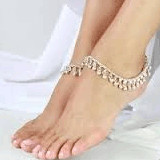 on the ankle of both legs. There are few clinging beads attached to it. As the woman walk the clinging sound of the anklet is heard. It is generally made of silver. Nowadays gold is also used.
on the ankle of both legs. There are few clinging beads attached to it. As the woman walk the clinging sound of the anklet is heard. It is generally made of silver. Nowadays gold is also used.
TOE RING
Toe rings are small rings worn on the toes. Wearing toe rings is a custom among some Hindu communities. It is usually made of silver. During the wedding ceremony the bridegroom put the toe ring on the brides toes. In North India toe rings are as important as a 'thali' (symbol of marriage). But nowadays it has become a fashion and is worn even by women of other communities.
| ||||||||||||||||||||||||||
| ||||||||||||||||||||||||||
| ||||||||||||||||||||||||||
| ||||||||||||||||||||
|








